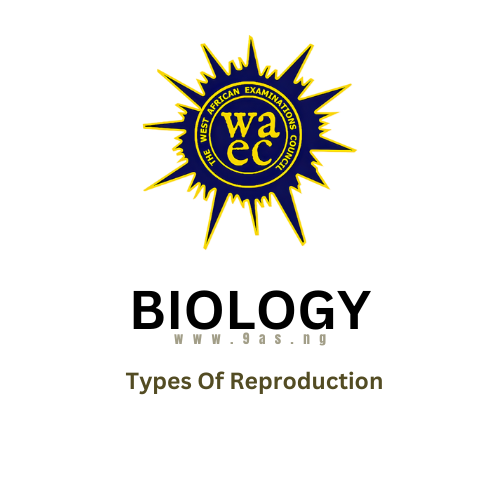Introduction:
Reproduction is a fundamental characteristic of living organisms, ensuring the continuity of species. It involves biological processes that lead to the production of new individuals. Understanding the types of reproduction is crucial for mastering WAEC Biology.
Key Concepts:
1. Definition of Reproduction:
Reproduction is the biological process by which organisms produce new individuals of the same species, ensuring the survival and continuity of the species.
2. Types of Reproduction:
- Asexual Reproduction: Involves a single parent and produces offspring that are genetically identical to the parent. Common methods include:
- Binary Fission: Seen in Amoeba and bacteria.
- Budding: Observed in yeast and Hydra.
- Fragmentation: Found in Planaria and some algae.
- Vegetative Propagation: Occurs in plants like Bryophyllum and ginger.
- Sexual Reproduction: Involves two parents and the fusion of male and female gametes, resulting in offspring with genetic variation. Examples include:
- Conjugation in Spirogyra.
- Fertilization in flowering plants and animals.
3. Differences Between Asexual and Sexual Reproduction:
| Feature | Asexual Reproduction | Sexual Reproduction |
|---|---|---|
| Number of Parents | One | Two |
| Genetic Variation | Offspring identical to parent | Offspring genetically diverse |
| Gamete Involvement | Not involved | Involves male and female gametes |
| Cell Division Type | Mitosis only | Both meiosis and mitosis |
| Speed of Reproduction | Generally faster | Generally slower |
| Adaptability | Less adaptable to environmental changes | More adaptable due to genetic variation |
4. Advantages and Disadvantages:
- Asexual Reproduction:
- Advantages:
- Rapid population increase.
- No need for a mate.
- Energy-efficient.
- Disadvantages:
- Lack of genetic diversity.
- Higher susceptibility to diseases.
- Advantages:
- Sexual Reproduction:
- Advantages:
- Genetic variation enhances adaptability.
- Potential for evolution and speciation.
- Disadvantages:
- Requires more energy and time.
- Dependence on the availability of mates.
- Advantages:
Study Tips:
- Understand Key Terms: Familiarize yourself with terms like gametes, zygote, mitosis, and meiosis.
- Use Diagrams: Practice drawing and labeling diagrams of reproductive systems and processes.
- Compare and Contrast: Create tables to highlight differences and similarities between asexual and sexual reproduction.
- Practice Past Questions: Regularly solve WAEC-style questions to test your understanding and improve exam readiness.
Conclusion:
Mastering the concepts of reproduction is essential for success in WAEC Biology. The questions provided above cover crucial aspects of the topic, and practicing them will enhance your understanding and performance.
Past WAEC questions on types of reproduction are available below for you to study with.
OBJECTIVES
1. The following events occur during mitosis in a cell:
I. Chromatids separate; II. Chromosomes become visible; III. Chromosomes align at the equator;
IV. Cytoplasm divides (Cytokinesis). The correct sequence of the events is
A. III, II, IV, I.
B. II, III, I, IV.
C. II, I, III, IV.
D. II, IV, I, III.
2. Which of the following statements about asexual reproduction is correct? It
A. always involves one parent but the offspring is genetically different from the parent.
B. may involve two parents but the offspring is always identical to one parent.
C. always involves one parent and the offspring is genetically identical to the parent.
D. involves two parents but the offspring is not genetically identical to any of the parents.
3. Which of the following methods is appropriate for the cultivation of cassava?
A. Budding.
B. Fragmentation.
C. Root, cutting.
D. Stem cutting.
4. A plant that commonly undergoes vegetative propagation by means of leaves is
A. Hibiscus.
B. Bryophylum.
C. Crotalaria.
D. Spirogyra.
5. Which of the following processes is a form of sexual reproduction?
A. Budding by yeast cells.
B. Conjugation in Spirogyra.
C. Binary fission in Amoeba.
D. Rhizome production by ginger.
6. A small stem from a hibiscus plant was placed in a nutrient medium, and it developed into a new plant.
The new plant was reproduced
A. asexually with a different genotype from the parent plant.
B. sexually with a different genotype from the parent plant.
C. asexually with the same genotype as the parent plant.
D. sexually with the same genotype as the parent plant.
7. Which of the following pairs consists of gametes?
A. Ova and spermatozoa.
B. Spores and sporangium.
C. Flowers and pollen grains.
D. Testes and ovaries.
8. Which of the following can be used for vegetative propagation?
A. Ginger stem.
B. Yam leaf.
C. Plantain roots.
D. Sweet potato tuber.
9. Which of the following is a method of artificial vegetative propagation?
A. Creeping stem.
B. Layering.
C. Corm.
D. Rhizome.
10. The advantages of sexual reproduction include the following except
A. it allows the formation of new species.
B. it allows production of desirable traits.
C. it permits variation of individuals.
D. it provide means for the variation of chromosome number from generation to generation.
THEORY
1. Name the two types of reproduction usually associated with organisms
2. (a) State five different methods used in vegetative propagation in plants giving an example in each case (b)(i) State five advantages vegetative propagation (ii) State five disadvantages of vegetative propagation (c) Mention four advantages of sexual reproduction.
3. What is sexual reproduction?
4. (a) Define asexual reproduction (b) Name two types of asexual reproduction which occur in animals giving one example in each case (c) In a tabular form outline four differences between sexual and asexual reproduction


